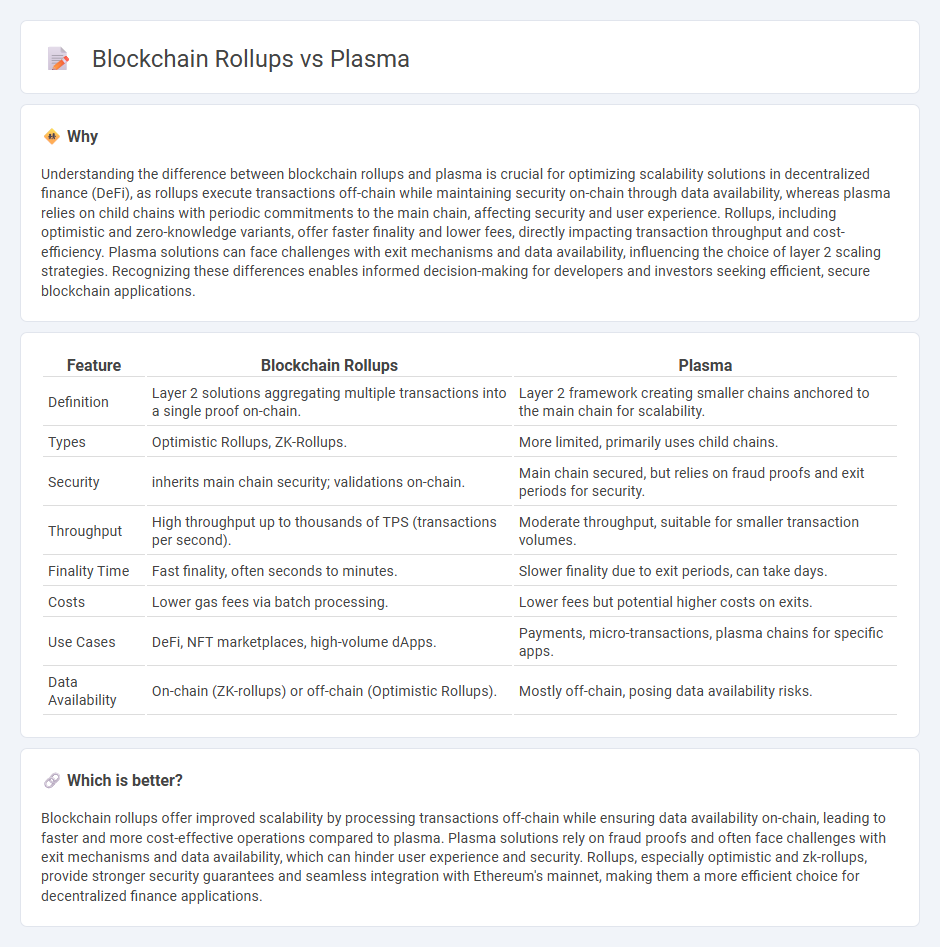
Blockchain rollups bundle multiple transactions into a single off-chain batch, significantly increasing scalability while maintaining security through on-chain data availability. Plasma creates child chains to process transactions off the main Ethereum chain, reducing congestion but facing challenges with data availability and withdrawal delays. Explore the differences between blockchain rollups and Plasma to understand their impacts on decentralized finance scalability.
Why it is important
Understanding the difference between blockchain rollups and plasma is crucial for optimizing scalability solutions in decentralized finance (DeFi), as rollups execute transactions off-chain while maintaining security on-chain through data availability, whereas plasma relies on child chains with periodic commitments to the main chain, affecting security and user experience. Rollups, including optimistic and zero-knowledge variants, offer faster finality and lower fees, directly impacting transaction throughput and cost-efficiency. Plasma solutions can face challenges with exit mechanisms and data availability, influencing the choice of layer 2 scaling strategies. Recognizing these differences enables informed decision-making for developers and investors seeking efficient, secure blockchain applications.
Comparison Table
| Feature | Blockchain Rollups | Plasma |
|---|---|---|
| Definition | Layer 2 solutions aggregating multiple transactions into a single proof on-chain. | Layer 2 framework creating smaller chains anchored to the main chain for scalability. |
| Types | Optimistic Rollups, ZK-Rollups. | More limited, primarily uses child chains. |
| Security | inherits main chain security; validations on-chain. | Main chain secured, but relies on fraud proofs and exit periods for security. |
| Throughput | High throughput up to thousands of TPS (transactions per second). | Moderate throughput, suitable for smaller transaction volumes. |
| Finality Time | Fast finality, often seconds to minutes. | Slower finality due to exit periods, can take days. |
| Costs | Lower gas fees via batch processing. | Lower fees but potential higher costs on exits. |
| Use Cases | DeFi, NFT marketplaces, high-volume dApps. | Payments, micro-transactions, plasma chains for specific apps. |
| Data Availability | On-chain (ZK-rollups) or off-chain (Optimistic Rollups). | Mostly off-chain, posing data availability risks. |
Which is better?
Blockchain rollups offer improved scalability by processing transactions off-chain while ensuring data availability on-chain, leading to faster and more cost-effective operations compared to plasma. Plasma solutions rely on fraud proofs and often face challenges with exit mechanisms and data availability, which can hinder user experience and security. Rollups, especially optimistic and zk-rollups, provide stronger security guarantees and seamless integration with Ethereum's mainnet, making them a more efficient choice for decentralized finance applications.
Connection
Blockchain rollups and Plasma are layer 2 scaling solutions designed to increase transaction throughput on Ethereum by processing transactions off-chain while maintaining security through the main chain. Rollups bundle multiple transactions into a single batch submitted to the Ethereum mainnet, whereas Plasma creates child chains that handle transactions independently before finalizing results on the mainnet. Both techniques aim to improve scalability and reduce gas costs by minimizing on-chain data processing and leveraging cryptographic proofs for transaction validity.
Key Terms
Data Availability
Plasma relies on off-chain transactions with periodic commitments to the main blockchain, which limits data availability as users depend on validators to provide transaction data. Blockchain rollups, particularly optimistic and zk-rollups, enhance data availability by posting compressed transaction data on-chain, ensuring transparency and verifiability. Explore further to understand how these mechanisms impact scalability and decentralization in blockchain ecosystems.
Fraud Proofs
Plasma utilizes fraud proofs to validate off-chain transactions by enabling users to challenge fraudulent state transitions within a specified exit period, ensuring security through economic incentives. Blockchain rollups implement fraud proofs more efficiently by aggregating transaction data on-chain and allowing verifiers to detect invalid state changes via succinct challenge games, which reduces latency and enhances scalability. Discover how fraud proofs in these technologies safeguard decentralized ecosystems and optimize transaction throughput.
Off-chain Computation
Plasma and blockchain rollups both enhance scalability through off-chain computation but differ in execution and security models. Plasma bundles multiple transactions off-chain, submitting only summary proofs to the main chain, relying heavily on fraud proofs for security, while rollups execute transactions off-chain but post comprehensive transaction data on-chain for immediate validation by all nodes. Explore in-depth comparisons to understand which solution best fits specific blockchain scaling needs.
Source and External Links
Plasma - Encyclopedia - University of Rochester Medical Center - Plasma is the largest part of your blood, a light yellow fluid that carries water, nutrients, hormones, proteins, and waste through the body, and includes key components like antibodies and clotting factors used in medical treatments.
What Is Plasma? Plasma Donation & Importance - Cleveland Clinic - Plasma is the liquid portion of blood making up about 55% of blood volume, composed of water, electrolytes, and proteins, and serves as a vital transport medium for blood cells and other substances throughout the body.
Plasma (physics) - Wikipedia - Plasma is the fourth state of matter, an ionized gas consisting of charged particles that exhibit collective electromagnetic behaviors distinct from solids, liquids, and gases.
 dowidth.com
dowidth.com